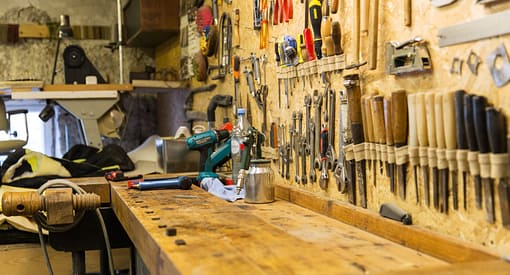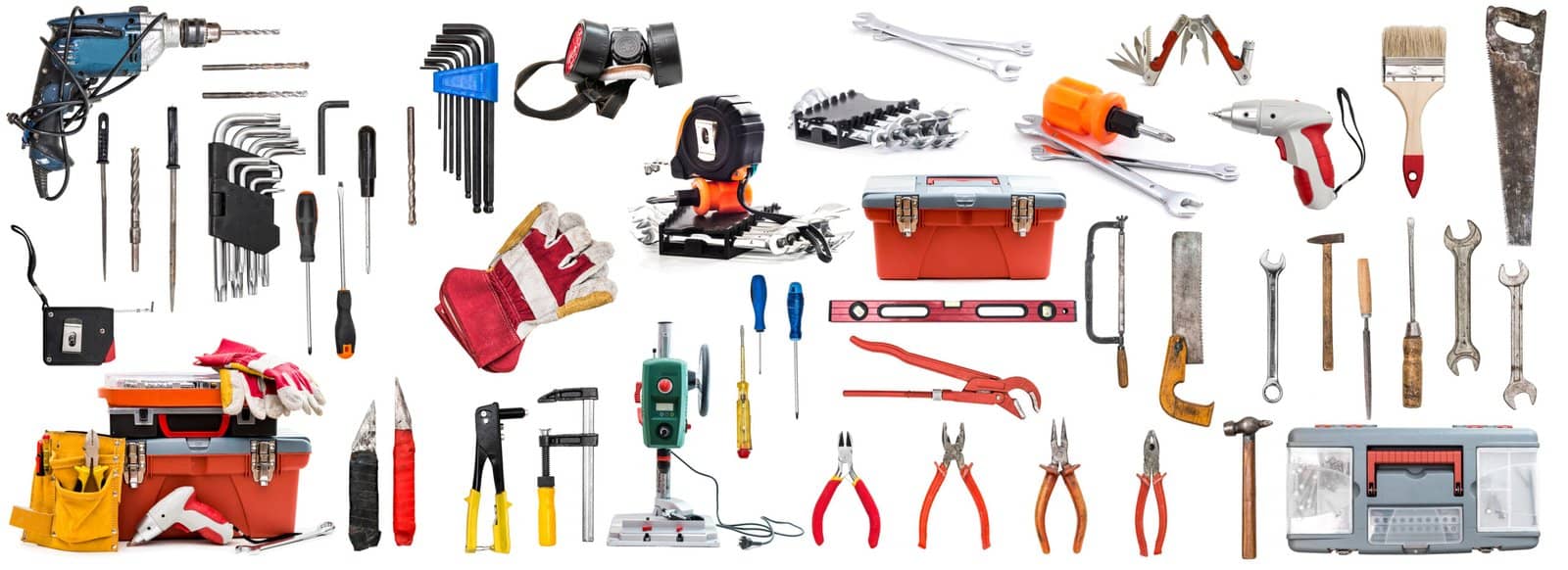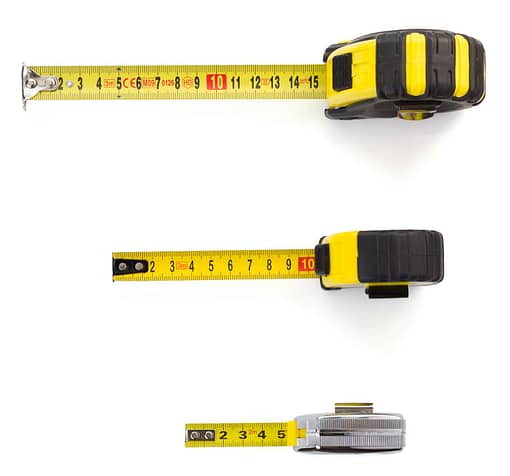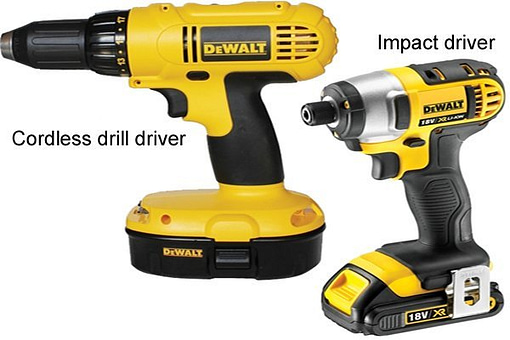You’re about to embark on a journey into the world of woodworking, where creativity meets craftsmanship. Whether you’re a seasoned woodworker or just starting out, there’s one question that lingers in the background: what is the most used tool in woodworking? This seemingly simple question holds the key to unlocking the secrets of this ancient craft. Get ready to discover the powerhouse tool that forms the backbone of every woodworking project, from intricate carvings to sturdy furniture pieces. Get ready to uncover the unsung hero of the woodworking world. Whether you’re a beginner or an experienced woodworker, having the right tools is essential for any project. From measuring and marking tools to cutting and shaping tools, there are numerous options to choose from. In this article, we’ll explore the wide range of hand tools, power tools, bench tools, safety tools, clamping tools, sharpening tools, layout and assembly tools, fastening tools, and finishing tools that are commonly used in woodworking. By the end of this article, you’ll have a comprehensive understanding of the tools you need to have in your woodworking arsenal.
Hand Tools
Measuring and Marking Tools
Before diving into any woodworking project, accurate measurements and precise marking are crucial. Measuring and marking tools allow you to ensure that your cuts, joints, and overall project dimensions are precise. Some of the most commonly used measuring and marking tools in woodworking include:
- Tape Measure: A tape measure is a staple tool in any woodworker’s toolbox. It allows you to measure lengths, widths, and heights accurately.
- Combination Square: A combination square is a versatile tool that can be used for measuring, marking 90-degree angles, and finding level and plumb lines.
- Marking Gauge: A marking gauge is used to scribe lines parallel to an edge, allowing for precise marking of dimensions or reference lines.
- Chalk Line: A chalk line is the perfect tool for creating straight lines over long distances. It uses a string coated in chalk powder, which is snapped against the workpiece to create a straight line.
- Carpenter’s Pencil: A carpenter’s pencil is larger and thicker than a regular pencil, making it easier to mark and draw lines on rough surfaces. Its flat shape prevents it from rolling away.
Cutting Tools
Cutting is a fundamental aspect of woodworking. Whether you’re making long rip cuts or delicate intricate cuts, having the right cutting tools is essential. Here are some commonly used cutting tools in woodworking:
- Hand Saw: A hand saw is a versatile tool used for cutting boards, plywood, and other materials. There are various types of hand saws, such as crosscut saws for cutting across the grain and rip saws for cutting with the grain.
- Backsaw: A backsaw is a hand saw with a rigid back, allowing for more precise and accurate cuts. It’s commonly used for joinery work, such as cutting tenons or dovetails.
- Coping Saw: A coping saw is specifically designed for making intricate curved cuts, such as detailed scrollwork or coping molding joints.
- Miter Saw: A miter saw is a power tool that makes accurate crosscuts and miter cuts. It’s commonly used for cutting moldings, trim, and framing components.
- Band Saw: A band saw is a versatile power tool that can make both straight and curved cuts in wood and other materials. It’s an ideal tool for resawing, shaping irregular contours, and cutting intricate patterns.
- Jigsaw: A jigsaw is a handheld power tool that excels at making curved cuts and detailed patterns. It’s great for cutting out shapes and creating internal cuts.
- Circular Saw: A circular saw is a handheld power tool that uses a circular blade for making long straight cuts in wood. It’s commonly used for cutting large plywood sheets and dimensioning lumber.

Joinery Tools
Joinery is the art of connecting two or more pieces of wood to create a strong and functional structure. To achieve precise and sturdy joints, you’ll need the following joinery tools:
- Chisels: Chisels are essential for shaping and cutting wood. They can be used for a wide range of tasks, including cutting mortises, paring joints, and chopping waste material.
- Dovetail Saw: A dovetail saw is specifically designed for cutting dovetail joints, which are commonly used in furniture and cabinetmaking.
- Router: A router is a power tool used for cutting a wide range of decorative and functional joints, such as dadoes, rabbets, and dovetails. It can also be used for shaping edges and creating decorative profiles.
- Biscuit Joiner: A biscuit joiner is a power tool that cuts slots for biscuits, which are small compressed wood pieces. Biscuits are then used to align and join two pieces of wood together.
- Pocket Hole Jig: A pocket hole jig is a tool used for creating pocket holes, which are angled holes that allow you to join pieces of wood with screws. It’s commonly used in cabinetmaking and furniture construction.
Shaping Tools
Woodworking often involves shaping wood into specific forms and profiles. Whether you’re creating decorative moldings, shaping edges, or forming curves, shaping tools are necessary. Here are some commonly used shaping tools in woodworking:
- Block Plane: A block plane is a small handheld plane used for shaping and smoothing wood. It’s great for removing small amounts of material and creating chamfers or bevels on edges.
- Spokeshave: A spokeshave is a small handheld tool with a curved blade used for shaping concave and convex surfaces, such as chair legs or curved handles.
- Rasps and Files: Rasps and files are used for shaping and smoothing wood by removing material. They are available in various shapes and cuts, depending on the specific task.
- Surform: A surform is a handheld tool with a replaceable blade used for rapid stock removal and shaping. It’s great for rough shaping and removing material quickly.
Finishing Tools
After all the cutting and shaping is done, it’s time to focus on the finishing touches. Finishing tools help you achieve smooth and polished surfaces, apply finishes, and bring out the beauty of the wood. Here are some commonly used finishing tools in woodworking:
- Sandpaper: Sandpaper comes in various grits and is used for smoothing surfaces and removing imperfections in the wood.
- Wood Files: Wood files are used for shaping and smoothing wood surfaces. They come in different shapes and cuts, allowing you to work on various contours and profiles.
- Brushes: Brushes are essential for applying paint, stain, or finish to your woodworking projects. Different brushes are suited for different types of finishes, so make sure to choose the appropriate brush for your project.
- Spray Gun: A spray gun is a power tool used for applying finishes, such as paint or varnish, in an even and consistent manner. It’s perfect for larger projects or when you need a smooth and professional finish.
- Wood Putty: Wood putty is a compound used to fill nail holes, cracks, and imperfections in wood surfaces. It’s available in different colors to match the wood you’re working with.
Power Tools
Table Saw
A table saw is a versatile and essential power tool in any woodworking shop. It consists of a circular saw blade mounted on an arbor, which is driven by an electric motor. It’s used for making straight cuts, crosscuts, miter cuts, bevel cuts, and ripping lumber. The table saw is a powerful tool that requires caution and proper safety measures.
Miter Saw
A miter saw, also known as a chop saw, is designed for making accurate crosscuts and miter cuts at various angles. It features a circular saw blade mounted on a hinged arm, allowing you to pivot the blade to make angled cuts. It’s commonly used for cutting moldings, trim, and framing components.
Scroll Saw
A scroll saw is a specialized power tool used for intricate and detailed cutting. It has a thin blade that moves up and down in a reciprocating motion, allowing for precise and intricate cuts. It’s often used for creating decorative scrollwork, fretwork, and intricate patterns.
Circular Saw
A circular saw is a handheld power tool that uses a circular blade for making long straight cuts in wood. It’s commonly used for cutting large plywood sheets and dimensioning lumber. Circular saws are available in corded and cordless versions, providing flexibility and mobility.
Jigsaw
A jigsaw is a handheld power tool that excels at making curved cuts and detailed patterns. It’s great for cutting out shapes and creating internal cuts. Jigsaws have a thin reciprocating blade that moves up and down, allowing for intricate cuts and curves. They are suitable for both straight cuts and curves, making them versatile tools in woodworking.
Band Saw
A band saw is a versatile power tool that can make both straight and curved cuts in wood and other materials. It consists of a continuous band of teethed metal stretched between two wheels and moves in a continuous motion. Band saws are ideal for resawing, shaping irregular contours, and cutting intricate patterns. They come in various sizes, ranging from benchtop models to large floor-standing models.
Router
A router is a versatile power tool used for a wide range of woodworking tasks. It can be used for cutting decorative and functional joints, shaping edges, creating profiles, and even carving intricate designs. Routers come in both handheld and table-mounted versions, providing flexibility and precision.
Random Orbital Sander
Once the cutting and shaping are complete, sanding is essential for achieving a smooth and polished surface. A random orbital sander is a power tool that combines rotating and vibrating motions to create a random sanding pattern. It’s perfect for removing imperfections, smoothing surfaces, and preparing wood for finishing.
Drill
A drill is a versatile power tool that is used for drilling holes and driving screws. It’s an essential tool in any woodworking shop. Depending on the type of work you’re doing, you can choose between corded drills or cordless drills. Cordless drills provide mobility and convenience, while corded drills offer more power and consistent performance.
Planer
A planer is a power tool used for dimensioning and smoothing rough lumber. It features a cutter head with multiple blades that remove material from the wood’s surface, resulting in a smooth and even finish. Planers are commonly used to bring rough boards to a consistent thickness and prepare them for joinery.

Bench Tools
Bench Vise
A bench vise is a clamping tool mounted on a workbench that holds workpieces securely in place. It’s an essential tool for woodworking, allowing you to hold and stabilize your workpieces while cutting, drilling, or shaping.
Bench Grinder
A bench grinder is a power tool used for shaping, sharpening, and buffing metal and woodworking tools. It consists of a motor that spins grinding wheels at high speeds, allowing you to remove material and shape edges with precision.
Bench Plane
A bench plane is a hand tool used for smoothing and flattening wood surfaces. It has a sharp blade mounted at an angle, allowing you to remove thin shavings of wood. Bench planes are essential for preparing surfaces for joinery and achieving a smooth finish.
Bench Chisels
Bench chisels are essential hand tools used for cutting and paring wood. They come in various sizes and are commonly used for cleaning up joints, cutting mortises, and shaping wood.
Workbench
A workbench is the foundation of any woodworking shop. It provides a sturdy and stable surface for cutting, shaping, and assembling wood. A well-built workbench is equipped with vises, bench dogs, and other accessories to enhance functionality and convenience.
Safety Tools

Safety Glasses
Safety glasses are essential for protecting your eyes from flying debris, dust, and other potential eye hazards. They are designed to provide impact resistance and minimize the risk of eye injuries.
Hearing Protection
Woodworking can be noisy, especially when using power tools that generate high levels of noise. Hearing protection, such as earplugs or earmuffs, is crucial for preserving your hearing and reducing the risk of hearing loss.
Dust Masks
Woodworking produces a significant amount of dust and fine particles, which can be harmful when inhaled. Dust masks are designed to filter out these particles and protect your respiratory system from dust-related health issues.
Gloves
Gloves provide protection for your hands when handling sharp tools, rough wood, or toxic materials. They can reduce the risk of cuts, abrasions, and chemical exposure.
Fire Extinguisher
In any woodworking shop, fire safety is of utmost importance. A fire extinguisher should be readily available and easily accessible in case of emergencies. It’s essential to know how to use a fire extinguisher properly and to have it regularly inspected.
Clamping Tools

Bar Clamps
Bar clamps, also known as F-clamps, are versatile and widely used for clamping workpieces together. They consist of a fixed and a movable jaw connected by a long bar. Bar clamps are ideal for securing large or irregularly shaped workpieces.
Pipe Clamps
Pipe clamps are similar to bar clamps, but instead of using a solid bar, they use a length of threaded pipe. This allows for greater flexibility in terms of clamping length and is particularly useful for long workpieces or when multiple clamps are needed.
C-Clamps
C-clamps are simple and widely available clamps that consist of a fixed and a movable jaw in the shape of a “C.” They are commonly used for a wide range of clamping tasks and are suitable for smaller projects or when a temporary hold is needed.
Spring Clamps
Spring clamps are lightweight and easy to use. They have a spring-loaded design that allows for easy one-handed operation. Spring clamps are great for holding small or delicate workpieces during assembly or gluing.
Quick Clamps
Quick clamps, also known as one-handed bar clamps, provide quick and easy clamping with just one hand. They have a trigger mechanism that allows for rapid adjustment and release. Quick clamps are ideal for quick setups or when working in tight spaces.
Sharpening Tools

Sharpening Stones
Sharpening stones, also known as whetstones, are used for sharpening and honing the cutting edges of chisels, planes, and other woodworking tools. They come in various grits, allowing you to achieve a sharp and polished edge.
Honing Guide
A honing guide is a tool that helps maintain consistency and accuracy when sharpening chisels and plane blades. It holds the tool at a specific angle and ensures that the cutting edge remains parallel to the sharpening surface.
Strop
A strop is a tool used for honing and polishing the cutting edges of woodworking tools. It consists of a strip of leather or other material attached to a flat surface. Strops are commonly used to refine the edges after sharpening with a sharpening stone.
Sharpening Jigs
Sharpening jigs are tools used to hold and guide sharpening stones or other sharpening devices. They provide consistent and repeatable angles, making it easier to achieve accurate and precise sharpening results. Sharpening jigs are particularly useful for beginners or when sharpening complex tools.
Layout and Assembly Tools
Squares
Squares are used to ensure that corners are precisely 90 degrees and that surfaces are square. They are available in various sizes and types, including try squares, combination squares, and sliding squares.
Marking Knife
A marking knife is a precision tool used for making accurate and clean lines on wood surfaces. It has a thin, sharp blade that allows for more precise marking than a pencil or marking gauge.
Carpenter’s Pencil
A carpenter’s pencil is a large, flat pencil designed for marking and drawing lines on rough surfaces, such as wood. Its flat shape prevents it from rolling away, making it convenient for quick and accurate markings.
Coping Saw
A coping saw is a hand tool used for cutting intricate curves and patterns in wood. It has a thin, narrow blade stretched between two arms and is commonly used for cutting detailed scrollwork or coping joints.
Framing Square
A framing square, also known as a carpenter’s square, is a versatile tool used for layout and checking right angles. It typically has a long tongue and a shorter body, allowing for a wide range of measurements and angle markings.
Fastening Tools
Screwdrivers
Screwdrivers are essential tools for driving screws into wood and other materials. They come in various sizes and types, including flathead, Phillips, and Torx, to accommodate different screw types.
Hammer
A hammer is a versatile tool used for driving nails, tapping wood joints together, or separating stubborn pieces. It’s available in various weights and designs, allowing you to choose the appropriate hammer for your specific task.
Nail Gun
A nail gun is a power tool that drives nails into wood using compressed air or electricity. It provides a faster and more efficient way of driving nails compared to traditional hammering. Nail guns are commonly used in framing, trim work, and construction projects.
Staple Gun
A staple gun is a handheld tool used for driving staples into wood, fabric, or other materials. It’s commonly used for attaching upholstery, securing cables, or fastening lightweight materials together.
Cordless Drill
A cordless drill is a versatile tool that combines drilling and screwdriving capabilities. It’s a convenient tool for woodworking, as it provides mobility and allows you to drill holes and drive screws without the need for a power outlet.
Finishing Tools

Sandpaper
Sandpaper is an essential tool for achieving a smooth and polished surface. It comes in various grits, from coarse to fine, allowing you to remove imperfections and refine the wood’s surface.
Wood Files
Wood files are used for shaping and smoothing wood surfaces. They come in different shapes and cuts, allowing you to work on various contours and profiles. Files are particularly useful for removing material quickly and shaping complex curves.
Brushes
Brushes are essential for applying paint, stain, or finish to your woodworking projects. Different brushes are suited for different types of finishes, so make sure to choose the appropriate brush for your project.
Spray Gun
A spray gun is a power tool used for applying finishes, such as paint or varnish, in an even and consistent manner. It’s perfect for larger projects or when you need a smooth and professional finish. Spray guns allow for efficient and controlled application, resulting in a high-quality finish.
Wood Putty
Wood putty is a compound used to fill nail holes, cracks, and imperfections in wood surfaces. It’s available in different colors to match the wood you’re working with, allowing for seamless repairs and finishing touches.
Conclusion: The Most Used Tool In Woodworking
Woodworking is a craft that requires a wide range of tools to accomplish various tasks. From measuring and marking tools to cutting, shaping, and finishing tools, each tool plays a crucial role in the woodworking process. Whether you prefer the precision and control of hand tools, the speed and efficiency of power tools, or the stability and convenience of bench tools, having the right tools at your disposal will allow you to bring your woodworking projects to life. Remember to prioritize safety by wearing appropriate protective gear, such as safety glasses and hearing protection. With the knowledge of these essential woodworking tools, you can embark on your next woodworking project with confidence. As to the most commonly used tool in woodworking, I’m sure you guessed already, yes it’s the ever-reliable tape measure.
















